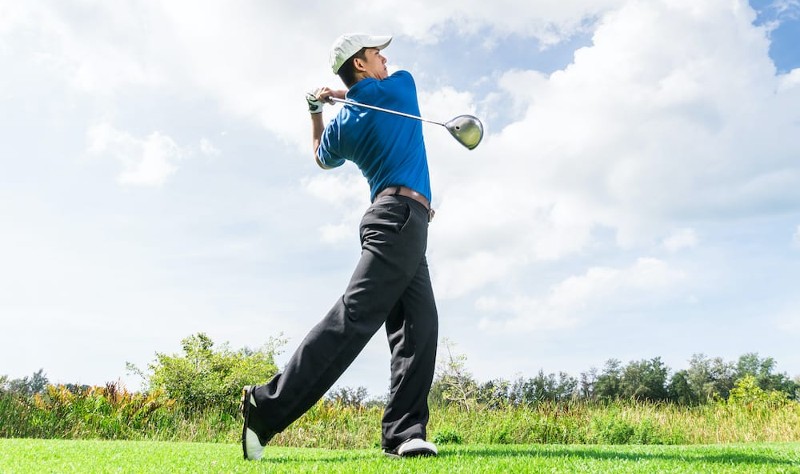|
Getting your Trinity Audio player ready...
|
Distance, as we’re taught, holds the secret to crafting an exceptional game of golf. Every golfer aspires to extend their drives and shorten the approach shots.
While precision simplifies life by keeping you on the fairway, a growing number of young golfers have embraced the bomb-and-gouge strategy.
They aim to drive the ball as far as possible and then utilize a short iron to reach the green, often succeeding even from the rough.
Bryson DeChambeau serves as a prominent example of a golfer who has embraced the bomb-and-gouge style, undergoing a significant physical transformation to enhance his driving capabilities.
He’s not alone in this approach among professional golfers.
Interested in boosting your driving distance? This guide will provide insights into refining your golf swing, selecting appropriate equipment, and avoiding common pitfalls.
Continue reading to acquire comprehensive knowledge.
How to Hit a Golf Ball Farther
Merely increasing swing speed won’t guarantee more distance. Consistently hitting the sweet spot is crucial for driving the golf ball effectively and competing with others, regardless of their ball dispersion.
It’s widely believed that each additional mile per hour of swing speed adds approximately three yards of extra distance.
Maintaining a relaxed swing fosters consistency, as tension is a major hindrance to both distance and accuracy.
Incorporating a consistent pre-swing routine, including breathing exercises, helps in focusing and relaxing before addressing the ball.
Minimizing the time spent over the ball is advisable to prevent negative thoughts from affecting accuracy.
Waggling your hands before the swing helps alleviate tension.
A wider swing arc translates to increased speed and consequently, greater distance. Generating torque in your lower body during the backswing contributes to enhanced club head speed.
To build torque, focus on creating resistance on your trailing leg while rotating around it without swaying away from the target.
This is the phase where weight transfer begins shifting to the back leg, with pressure exerted on the back foot against the turf.
Expanding the arc involves pushing the golf club back as far as possible while maintaining balance and control.
Keeping your arms straight facilitates a larger swing arc. Wrist cocking optimizes the club’s distance during the downswing.
For maximum speed, initiate the downswing with your lower body, capitalizing on the built-up torque from the backswing.
The weight transfer initiated during the backswing undergoes reversal at the swing’s peak.
This maximizes body rotation, shifts the bottom of the swing arc forward, and enables optimal compression of the golf ball upon impact.
Maintain wrist cocking until your hands reach below hip height to ensure maximum speed.
Prematurely releasing the hands results in peak speed midway through the swing, leading to a casting action.
Maximum speed is often accompanied by a swooshing sound produced by the clubhead, ideally occurring immediately after impact.
Grounding your feet during the swing and correcting weight transfer enhance stability and maximize speed.
Read More: How To Measure Putter Length
How To Improve Your Strength and Flexibility
Improving your physical fitness and flexibility is crucial for maximizing swing speed and minimizing the risk of injuries.
Increased flexibility facilitates a longer backswing and greater downswing distance.
Prioritize proper physical conditioning to optimize swing speed and reduce injury potential.
Pre-round stretching enhances flexibility and has been shown to increase swing speed.
Given that the golf swing primarily engages the core muscles, it’s essential to target specific areas for strengthening and tailor your training regimen accordingly.
A strong core enhances stability throughout the swing and enables maximum torque generation.
Key muscle groups to strengthen include:
- Glutes
- Abdominals
- Back
- Forearms
- Wrists
Recommended exercises to target these muscle groups include:
- Squats for upper legs, glutes, and lower back strength
- Single-leg squats with arm reach for advanced strength and control
- Back extensions for back flexibility and strength
- Hip loaders for posture and lateral movement improvement
- 90/90s to strengthen glutes
- Forearm pronation and supination exercises for forearm strength
- Wrist extension exercises
- Rotational lunges for lower back and glute strength, and hip engagement
The Right Equipment for Driving
Choosing equipment tailored to your swing and physical attributes maximizes performance.
Consider scheduling a club fitting session with a professional club fitter to ensure optimal equipment selection.
Your swing speed dictates the ideal loft for your driver.
Slower swing speeds necessitate higher loft angles to generate more height and counteract spin reduction.
Shaft characteristics, including flex, weight, torque, and kick point, significantly impact performance.
A shaft with excessive flex can result in increased spin and reduced distance.
Utilizing a launch monitor aids in monitoring progress and identifying areas for swing improvement to enhance swing speed and drive distance.
In addition to equipment selection, focus on physical conditioning and proper swing mechanics. Utilize training aids to monitor and refine weight transfer and swing tempo.
Read More: Driver Shaft Length by Height
How to Drive a Golf Ball: 10 Stage
The listed steps will guide you on how to hit your golf balls longer attempting to improve your golf game on the golf course. With regular practice, you will improve your golf scores.
Step #1: Choose the Proper Loft
A proper loft driver needs to be selected. We now recommend a 9 or 10-degree loft, as opposed to the past when golfers would use a 7 or 8-degree loft.
The loft is important particularly for beginners, as it will let you hit the golf shots with more consistency.
Step #2: Pick the Right Club
It all depends on the hole, and a driver will not always be necessary. A 3, 5, or 7 wood will suffice if on a par 3.
Swing speed is often used as a yardstick to decide which club to buy. Irons will produce a higher loft than wood. For close-range pictures, iron sometimes is sufficient.
Step #3: Get into Position
As you get ready to shoot, position your body with a vertical object in the distance. You may go for a tree, person, or bush that is far away.
Vertical markers work the best because the eyes know where to hit it hard. Do not bend your left elbow too soon since it can decrease your distance.
Step #4: Proper Positioning of Feet
You have to set your feet in the right direction. Align the ball to the left heel of the front foot. Watch out not to place the ball too much in front.
You want the club to have good contact with the ball.
When you approach to hit the swing, the distance between the feet should be one and a half of the feet.
If you strike an iron, you need to stand two feet apart. You need to hit an attractive equilibrium so that your club touches the ball just nicely.
Step #5: Position Your Arms
Additionally, you must place your arms correctly. In a V position, your arms must be straight. The club should be flat on the ground in your hand, leading edge facing front.
Step #6: The Right Pressure
Squeezing the club tighter and hitting harder will not produce the desired consequences. Too much pressure will result in inconsistent ball striking.
The concept of holding a bird gently was introduced by Phil Galvano, a famous golf instructor. You don’t like stepping on the bird, and neither do you like it to fall away from your palms.
Step #7: Choose the Right Swing
You can choose from two types of swings: swing power and swing control.
A crowder was designed to hit the ball as far as possible regardless of accuracy.
Giving control swing is what serves you as an advantage with accuracy and was intended for you to avoid sand traps, trees, and water hazards.
Step #8: During the Swing
You need to remain relaxed and deliberate during your golf swing. You accelerate as the club approaches the ball. Footprints will make the sweet spot more elusive.
Step #9: Favor the Angle Toward Your Leading Hand
Most of the beginners will push their hands in front to launch a ball. On the follow-through part, you will tend to move your hand down to the ball.
Step #10: Follow through with the Swing
When you complete the swing, the club head will go over your shoulder. For a right-handed golfer, the club swings over the left shoulder, while for left-handers, the club swings over the right shoulder.
You do not have to hurry to look up to see where the ball has landed. Properly executing all the correct steps will lead the ball to the required position.
Most Important Things to Know When Driving the Ball
To start with, the hold you apply to the club will show itself when you hit the ball. Do not minimize the effect this will have.
Second, mind your loft because that is important while playing golf.
Lastly, give your swing special consideration do not feel that you can muscle through it quickly as this will undermine your consistency.
You begin at a slow pace and accelerate when you get near the golf ball. This is what the golf ball is struck with a driver.
5 Tips to Drive a Golf Ball
Tip #1: Widen Your Stance
As to the driving form, golf stance, you have a wider foot placement since it provides you with a more stable platform to swing from.
It makes sure that while you are making the swing, it won’t make you lose balance.
Tip #2: Practice with a Launch Monitor
More and more PGA pros are taking their launch monitor to the golf course. Launch monitors will provide you the benefit of specifics such as club speed, launch angles, spin rates, and smash factor.
A launch monitor will enable you to understand your swing mechanics on the course.
Tip #3: Work on Decreasing Your Spin Rate
Starting to learn to drive a ball, most beginners suffer from the excessive spin rate that kills distance. Over-spin rates occur when a ball is hit downwards, creating too much backspin.
Tip #4: Begin with More Weight on the Trailing Foot
You aim to generate additional traction force toward the inward of your right thigh. The goal is for 60 percent of the load on the right glute.
The pressure on the rear right foot would give a stronger punch during the swing.
Tip #5: Head to the Gym
That could be an absurd idea for the game of golf, but Tiger Woods was the person who let the new breed of golfers look beyond the course.
You want to be a powerful dynamic driver. Proper fitness enables the ball to be hit over longer distances. This encapsulates the pointers for driving the golf ball.
FAQs
Q1. Where Should You Stand When Driving a Golf Ball?
Ans: Maintain a shoulder-width stance with the ball positioned just inside the left heel. Distribute body weight evenly during setup.
Q2. Where Do You Look When Driving a Golf Ball?
Ans: Focus on the front edge of the golf ball to ensure an inside-out swing path and optimal contact.
Final Thoughts
Swing speed plays a pivotal role in driving distance improvement. Maintain physical fitness and understand swing mechanics to refine your game without constant coaching.
Strengthen your core, warm up before rounds, and focus on targeted exercises to enhance performance and minimize injury risks.
This holistic approach will elevate your golfing prowess, enabling you to consistently hit the ball with precision and power toward your target.





